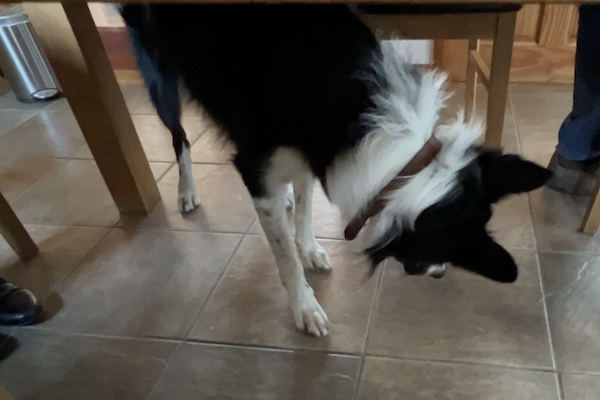Border collie repetitive behaviour, also know as compulsive behaviour or stereotypical behaviour is defined as “repetitive, constant, and appear to serve no obvious purpose”. Examples include: shadow or light chasing/fixating, tail chasing, spinning, fly snapping, repetitive licking of legs and feet, digging or scratching at the floor and pica (eating inedible items such as stones). Collies are one of the breeds that tend to be prone to certain repetitive behaviours, most frequently shadow chasing, tail chasing and fly snapping.
The following diagram, taken from Salonen et al, 2020, shows the most common border collie repetitive behaviour practised by a sample of over 200 border collies in Finland. It shows that light chasing/fly snapping and staring (fixating on something such as shadows, lights, water, sand etc) were the most practised repetitive behaviours in the sample of dogs used in the study. Categorising shadow chasing and fly snapping in the same category was not ideal because they are both thought to be caused by different mechanisms.
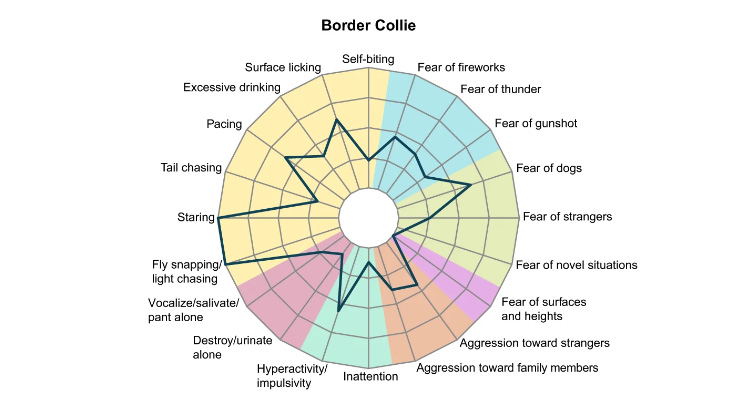
Owners can find it distressing when their dogs spend so much of their day practising these behaviours instead of doing “normal” dog activities, but is it always the best idea to prevent the dog from performing the behaviour?
Do we even want to stop the behaviour?
One question we need to ask is, is it in the dog’s best interest to prevent them from practising the behaviour? If we can establish that a dog is using repetitive behaviours as a coping strategy, then letting them continue until we can resolve the underlying issue may, in some cases be kinder.
Studies comparing farm animals that practised stereotypies with animals living in the same situation that do not practise stereotypies found that former were less stressed than the latter group, revealing that the stereotypies were, in fact, helping the stereotypy-practising animals to better cope with their environment (Mason and Latham, 2004).
As an example, a dog I saw that had recently lost their key carer. Following this loss, she had started repetitively licking other family members. We established that this was a need for comfort and was helping her to cope with the loss. The owners were advised not to tell her off, ignore her or get up and walk away. Instead, we taught her an alternative behaviour, resting her head on their laps, for which she received as much attention as she wanted, with less attention for licking. Eventually the head resting replaced the licking, meeting the dog’s needs without causing her further distress.
In all situations we need to weigh up the pros and cons and decide what is best to do. A behaviourist will help with this.
However, in a second example a collie was spinning for very high percentages of the day, which had become a coping strategy for pain she was feeling due to hip dysplasia. Allowing her to practise the behaviour was having a detrimental effect on her physically, and so we were forced to try to reduce the spinning.
1. Attention-seeking
One of best ways to determine if your dog is practising the behaviour in hope of getting your attention is to set up a camera to observe them when you aren’t present. If they don’t practise the behaviour when you are not present, then it could be attention seeking. HOWEVER, this is not always the case. For example, there are more shadows to chase when people are present and moving, and in some instances collies will perform repetitive behaviours due to stress when certain people are present for various reasons. Another way to determine if collis are performing the behaviour to get you to interact with them is to watch them closely. Are they glancing at you every so often to see if you have noticed what they are doing? If so, this can be a sure sign that they have learned that performing the behaviour results in you distracting them with toys, calling them over, or something else that they will enjoy.
The obvious answer to ruling out attention seeking as your collies’ motivation for performing a repetitive behaviour is to ignore the behaviour whenever it occurs in an attempt to “extinguish” the behaviour. However this is easier said than done. For extinction of a behaviour to work, we must ignore every single incident. Ignoring most but responding to a few incidents is creating a variable reinforcement schedule which is the best way to strengthen a behaviour.
If there is any chance that you can’t ignore every single incidence of your dog’s compulsive behaviour, then it is best to move away from your dog as soon as it happens. Just walking out of the room is the best way to manage this.
Alternatively, pre-empting the behaviour by giving your dog another activity to do will help to prevent your dog from practising the behaviour (see below).
2. Interrupting the behaviour
Practising a behaviour makes a dog more likely to continue to practise a behaviour. This is similar to when we learn to drive – we just do it without even thinking. This is what can happen with dogs with abnormal repetitive behaviours. Limiting the amount of time they practise the behaviour can help with reducing it over the long term.
However, just redirecting your dog onto another activity, calling them over or even telling them off may all be reinforcing for your dog, making the behaviour more likely. Dogs start to backchain and learn that if they chase shadows, at some point you will interact with them and something fun or just less boring might happen.
We therefore need to interrupt the behaviour without giving the dog any attention, not looking at him and definitely not speaking to him. There are various ways of doing this, and you will need a few different ideas as dogs start to lose interest if you try the same thing too many times. Some of the more successful ways of interrupting a repetitive behaviour include:
- Juggling with the dog’s toys (or attempting to)
- Picking up one of the dog’s toys and talking to it as though it is the most fascinating thing you have ever seen
- Knocking on a nearby table
- Paying a lot of attention to another dog, if you have one, and very vocally praising him
- Leaving the room
- Making a strange sound repetitively until the dog comes over
Once you have the dog’s attention, continue to ignore him for a few more minutes (don’t look at him or speak to him), then ask him to do a behaviour such as sit, give a paw, lie down etc. And only then praise him and give him something else to do, preferably something with a bit of duration, that will keep him entertained and stop him going back to the repetitive activity.
3. Use a diary
Use a diary to record any instances of your collie’s repetitive behaviour. Record what your dog was doing just before starting the behaviour, who else was there and what they were doing. Think about what triggered the behaviour and what happened afterwards – what did you do and what did your dog do?
This can be time-consuming but it will allow you to see patterns in the behaviour, and start to see peak times when the behaviour occurs. This will be extremely helpful for any behaviourists or vets that you work with.
4. Reducing homeostatic load
Homeostasis is a state of balance that our bodies require for us to survive and function. Anything that knocks the balance of our body systems can cause us stress. So, for example, being scared, frustrated, anxious or very excited can release neurochemicals into the blood that take us further away from homeostasis, meaning that our bodies have to use energy to bring us back. The same goes for:
- Anything that affects our microbiome
- Being tired, mentally or physically
- Pain or disease
- Boredom or frustration
- Extremes of temperature
- Hunger or thirst
- Threats – real or perceived
- Major environmental changes (we know that animals that practise repetitive behaviours are more likely to struggle with change (Whitehouse et.al., 2017)).
- Lack of predictability or choice
- Lack of a safe haven (somewhere the animal can go to feel safe)
5. Identify the trigger and reduce exposure to it
As described above, one of the most important things to remember in relation to problem behaviours is that the more a dog practises a behaviour, the more they will continue to practise it. We need to prevent them from practising the behaviour and teach the dog a new way of behaving in that context. Exactly the same thing applies with repetitive behaviours. So we need to limit the amount that the dog practises the behaviour.
So if your collie shadow chases, then we will need to limit the amount of shadows he can see and react to. Collies are often worse in certain areas of the house, often the kitchen because this is where we move about more, preparing food and washing up, creating more moving shadows. So if this is the case, keep your collie out of the kitchen when you are moving about. Similarly, if your dog chases its tail when people come to the door, keep your collie away from the front door. If your dog reacts to puddles or water, use a long line to guide him away from these before he sees them.
The aim is not to completely eliminate all triggers, but just to remove those that your dog are most likely to react to. E.g.Use a long line outdoors to guide away from triggers before the dog has noticed them.
6. Make the trigger a cue for a different behaviour
In some cases, making the trigger a cue for the chance to perform a different behaviour and earn a reward can be a good option. We would introduce a low intensity trigger (e.g. feint shadows on a cloudy day) and as soon as the dog looks at it, cue a behaviour that the dog really enjoys such as a hand touch. In this way, the dog can be taught to notice the trigger and turn back to the handler. This can be particularly useful for dogs that chase lights or reflection because these can be controlled.
For this training to work, the trigger must be removed at all other times so that the dog’s only experience of the trigger is as a cue to earn a reward.
7. Change or re-arrange the environment
Within the hippocampus, a key region in the brain involved in long term memory, there are cells known as place cells. Stimulation of these cells, when in a triggering environment, will activate a particular behaviour that has been practised previously in that environment. These place cells have a significant impact in triggering previously learned behaviour. (Robinson et.al., 2020).
Therefore, by changing the environment a little, such as moving around the furniture, or changing rooms we settle in to watch tv, or by redecorating, we can make a room or place look completely different to a dog. This is less likely to activate the place cells in the hippocampus, making it easier for the dog to learn new ways of behaving in the new place and NOT practise the unwanted behaviour.
With Gloria, a 2 year old collie I worked with who had intense hip pain which caused her to circle constantly, we moved a few bits of furniture in the lounge and set up barriers in the office making it harder for her to circle. This was very successful in dramatically reducing the behaviour. It was important to stop her from circling because even though it was a coping strategy that made her feel better, it was causing further damage to her hips.
8. Pre-empt the behaviour – with another activity
Pre-empting the behaviour is important because we don’t want to reward the repetitive behaviour by reacting after it has started. If we present an activity before the behaviour begins, then we are not risking reinforcing it.
Use the diary to note any times at which the behaviour reliably occurs and have activities prepared to give your dog BEFORE they start the behaviour. So, for instance, if you have a shadow chaser who is worse around mealtimes, prepare a range of activities, such as:
- A lickimat or kong with their favourite topping. Freezing these will make them last longer.
- A snuffle mat with tiny bits of food hidden inside.
- A treat-dispensing toy such as a kong wobbler or a treat ball.
- Free work – this video explains this really well.
- A forage box – see this article for further details and other enrichment ideas.
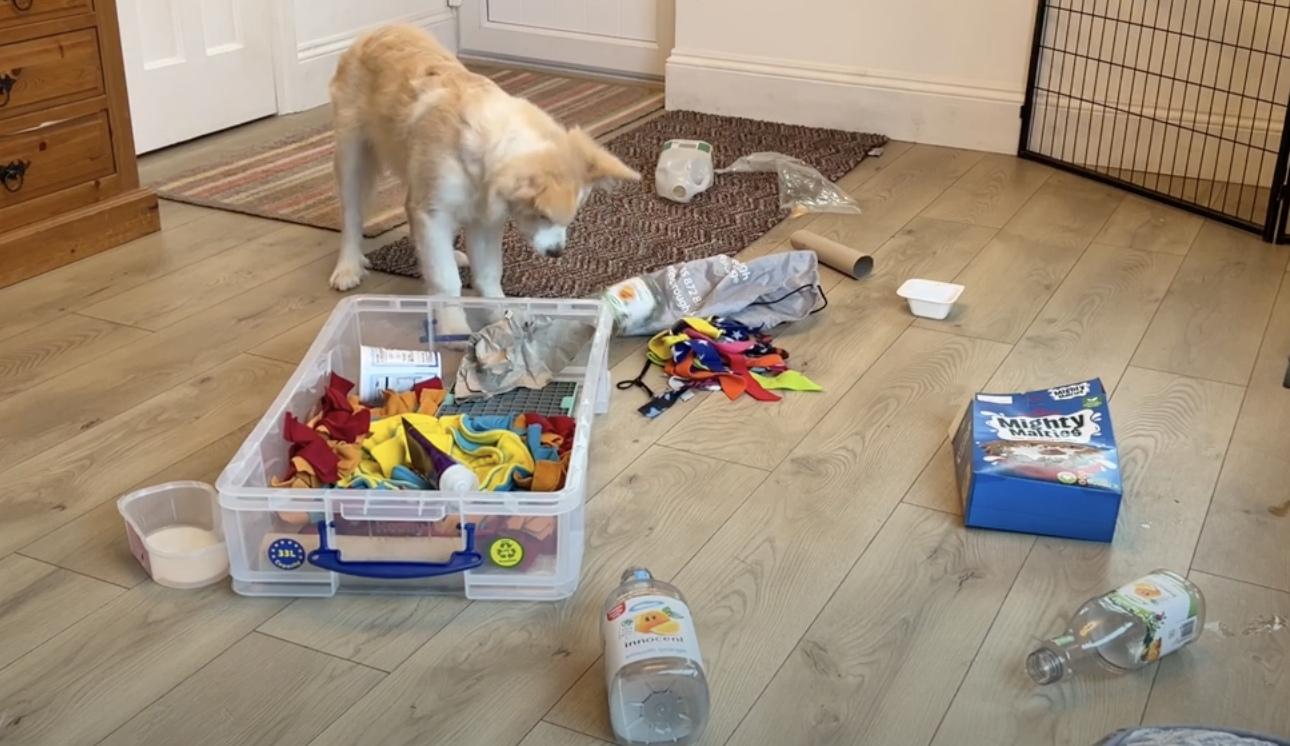
Before your dog starts to shadow chase, present one of the enrichment ideas.
Keep an eye on your dog and just before he starts to get bored and wanders off, take him into the garden to the toilet and for a sniff round. This acts as a reset and calms them again. Then back inside to the next activity. Keep going until the danger period for shadow chasing has passed.
If your dog shadow chases for most of the day, start to work first on peak times and then gradually extend into other times when you have got into the routine of presenting activities and preparing them.
This can be time-consuming but it is an essential, proven, successful method for preventing your dog from practising the behaviour, which is key to long term reduction or cessation of the behaviour.
9. Cease punishment
As positive trainers, we should ideally never be punishing dogs. This is particularly true when managing border collie repetitive behaviour. Because it is so often caused by pain, stress or social conflict, punishment just adds more stress to the situation for the dog to deal with. This could potentially make the behaviour worse.
We should instead set the dog up to succeed by reducing the opportunity the dog has to practise the behaviour, as described above, and by providing alternative behaviours for your dog to practise instead. We are then able to reward the dog for doing the right thing rather than having to get into the negative trap of always being negative and telling the dog what NOT to do instead of giving him something that we DO want him to do.
10. Improve relationship between owner and dog
Because the most common causes of border collie repetitive behaviour tends to be social conflict or anxiety, then sometimes just working on improving our relationship with our dogs can help reduce repetitive behaviours.
Key to this is setting the dog up to succeed so that they don’t have options to do unwanted behaviours, then we can praise them for being right, instead of following them round being annoyed. For instance, if your dog tends to run round with wellies, then keep the wellies somewhere where he can’t access them. If he chews certain areas in the house, block his access or cover them with something. If he barks at people out of the window, keep him away from the window by keeping him in a different room, block access to the window or add a frosted glass film to the window so that he can’t see out.
Leading on from this, try to get in the mindset that if your dog is doing something you don’t want him to do, tell him what you DO want him to do instead. It’s much easier for dogs to understand. So instead of jumping up, ask for a hand touch or a sit and then you can praise him.
Dogs thrive when they are in a routine and know what to expect, so try to keep to the same routine each day of the week. Having a different routine at weekends is fine so long as it stays roughly the same each weekend day.
Training can be great for creating consistent, calm and clear owner communication with your dog. Sometimes just daily training of a few exercises (see below) can really improve your relationship with your dog and provide enrichment for him as well.
Once your relationship starts to improve, you will notice that your dog may start to come to you when he is worried, so you are acting as a secure base for your dog, which will give him the confidence to be more able to cope with things that make him anxious.
Shared attention – if you have a good bond with your dog, then where you look can sometimes be very influential. So if your dog is shadow chasing, try not to look at the shadows yourself.
11. Training
As explained above, training anything can help immensely with building an improved relationship with your dog, but the following training will be particularly useful for helping to reduce or resolve repetitive behaviours.
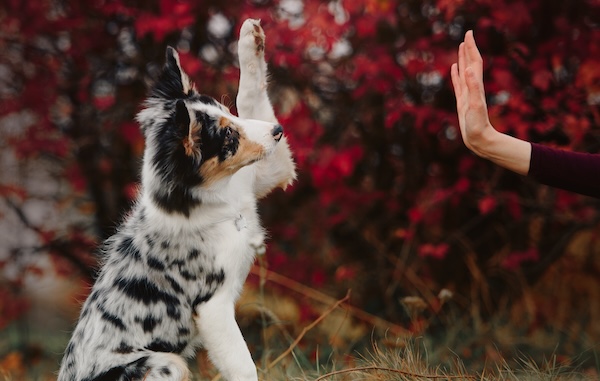
- High – low arousal changes – these sorts of behaviours can help to give your collie an “off switch” so that if he starts to become over-aroused by performing his repetitive behaviour, you are able to help him to calm down quickly.
- Mat training – perfect as a duration behaviour and a behaviour that is likely to be incompatible with many common collie repetitive behaviours.
- Hand touch – a useful tool to use after interrupting your dog’s behaviour to get him to focus back on you.
- Go to place – similar to the mat training, but the “place” (a bed or mat) is down all the time, and we can teach the dog to go to his place on cue, preventing him from practising most repetitive behaviours. This should not be used as a punishment in the same way that many people send their children to their room. It should be a positively taught fun activity, with the dog well reinforced for going to his place.
- Sheep balls – this can be a useful game to play if your dog chases shadows in the garden, or is prone to fly snapping, circling or tail chasing. It is a game that most collies inherently adore, enabling them to practise many of their natural herding behaviours. It is also much better for their bodies than repetitive ball throwing. Find out more about sheep balls.
- Pattern games – pattern games, such as those created by Leslie McDevitt, can be a great alternative to practising repetitive behaviours. Pattern games are inherently calming and lower stress, making it easy for dogs to stay calm with arousal low. Find out more about pattern games.
- Free work – as designed by Sarah Fisher, a well-known veterinary behaviourist, free work is a calming activity that dogs enjoy, giving them something to do for 10 -20 minutes or longer. Perfect for pre-empting the repetitive behaviour. Find out more about free work.
- Movement puzzles – a great new concept game that involves teaching your dog to navigate different obstacles. Perfect for dogs recovering from injuries or surgery, and also ideal as a training activity to build up your dog’s confidence. Fnd out more about movement puzzles.
- Mousey mousey – a great game for shadow chasers – we cover the “mouse” (a titbit) on the floor under our hand. Then we slightly lift our hand and flick the mouse one way, then another. In the same way as watching shadows, the dogs build up excited anticipation about the “mouse” moving and catching the treat. See this video.
12. Reward relaxation
So often we concentrate so much on what our dogs are doing “wrong” that we don’t notice when they are doing things that we DO want them to do. This is often the case when collies are relaxed – we are so relieved that they have finally settled down that we often use this time to get on with other things, or enjoy the peace and quiet. However, we really need to be rewarding their choice to be calm and settled.
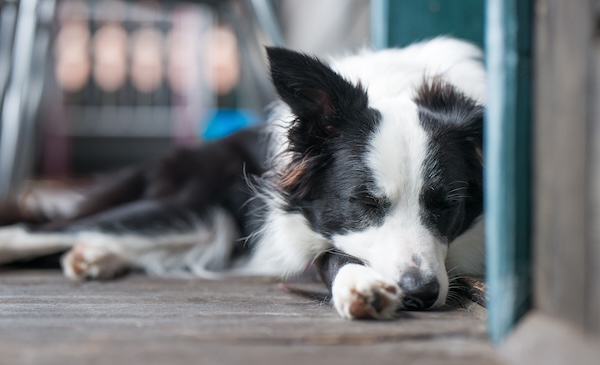
This reward shouldn’t be exciting so that they jump straight up again. Instead, just walk over to where your dog is settled, don’t make eye contact, and either say “good” very quietly, then give them a treat, just placed in between their paws and walk away again. If this immediately makes your dog leap up, just give them gentle praise from a distance, just to let them know that settling is really good, and they can get more attention from us if they are relaxed than if they are chasing shadows, circling, licking the floor or snapping at flies.
In some cases, it can be beneficial to reward EVERYTHING that isn’t the repetitive behaviour.
13. Change of diet
If your dog is repeating oral type behaviours, such as repetitive licking, chewing or fly snapping, then a change of diet can sometimes help.
iscuss with your vet which diets they think are most suitable for your dog.
14. Vet liaison
As behaviourists, we need to be able to access your dog’s medical records. These can be really helpful in determining:
- any medical conditions which could be contributing to the behaviour
- how your dog interacts with the vet
- any concerns about temperament noted by the vet
- any other information that may be useful
- to help build a timeline
It’s also very important to be able to liaise with your dog’s vet because anxiety medication can often help to reduce the intensity and frequency of repetitive behaviours. And if we suspect that pain or discomfort may be involved, we can discuss this with your vet to ensure that we get the best outcome for your dog.
Noh et. al., 2017, concluded, after an extensive investigation into how compulsive disorders in dogs, humans and mice are implicated by genetic factors, that SSRIs (selective serotonin reuptake inhibitors), an anxiolytic medication group commonly used for humans and dogs, are the most effective available OCD treatment.
15. The rebound effect
Studies have shown (Wegner et al., 1987) that suppressing a behaviour can actually make the behaviour worse in the long term. A mechanism known as the rebound effect can cause us to become more focused on a behaviour if we have been prevented from practising it. The same is theoretically true with dogs – if we physically prevent them from practising a repetitive behaviour, by having them on a lead, for example, then when the lead is removed, the behaviour could become worse.
If you need any help with resolving your border collie repetitive behaviour, please contact us for help!
References:
Langen M, Kas MJ, Staal WG, van Engeland H, Durston S. The neurobiology of repetitive behavior: of mice…. Neurosci Biobehav Rev. 2011 Jan;35(3):345-55. doi: 10.1016/j.neubiorev.2010.02.004. Epub 2010 Feb 13. PMID: 20156480.
Mason, G.J. and Latham, N. (2004) Can’t stop, won’t stop: is stereotypy a reliable animal welfare indicator?
Noh, H.J., Tang, R., Flannick, J. et al. Integrating evolutionary and regulatory information with a multispecies approach implicates genes and pathways in obsessive-compulsive disorder. Nat Commun 8, 774 (2017). https://doi.org/10.1038/s41467-017-00831-x
Robinson, N. T., Descamps, L. A., Russell, L. E., Buchholz, M. O., Bicknell, B. A., Antonov, G. K., … & Häusser, M. (2020). Targeted activation of hippocampal place cells drives memory-guided spatial behavior. Cell, 183(6), 1586-1599.
Salonen, M., Sulkama, S., Mikkola, S. et al. Prevalence, comorbidity, and breed differences in canine anxiety in 13,700 Finnish pet dogs. Sci Rep 10, 2962 (2020). https://doi.org/10.1038/s41598-020-59837-z
Wegner, D. M., Schneider, D. J., Carter, S. R., & White, T. L. (1987). Paradoxical effects of thought suppression. Journal of pe rsonality and social psychology, 53(1), 5. Whitehouse, C.
Whitehouse, C. M., Curry Pochy , L. S., Shafer, R., Rudy, J., & Lewis, M. H. (2017). Reversal learning in C58 mice: Modeling higher order repetitive behavior . Behavioural brain research, 332, 372 378.

